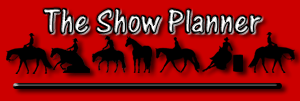 |
|
Show Horse Promotions Mary Murray
|
A Horse, Of Course
|
Wobbler Syndrone |
|
Pick the biggest, prettiest, healthiest-looking colt in the pasture and chances are “fair” he’ll soon be stumbling and falling and he won’t be able to trot or run. He’ll be a wobbler! The wobbler syndrome shows up most frequently in the young and healthy LARGE horse. But, of course, that’s what so many breeders and horse lovers want… big young horses. According to Dr. Antonio M. Cruz, veterinary teaching hospital, University of Guelph, the wobbler syndrome includes a group of diseases characterized by gait instability. The most common disease associated with “wobblers” is cervical vertebral stenotic myelopathy, producing a spinal cord compression at the neck level, Dr. Cruz says. According to most authorities, the perception that the problem is increasing may actually be due to an increased awareness and more expertise in diagnostic methods. At the same time, what may seem to be an increase may actually be an increase, since most agree, “a strong dietary component is involved in this disease.” Horse breeders want to grow them big and grow them fast. A lot of horses will never be diagnosed correctly since many will never be considered “serious” enough to go through the complicated diagnostic process. A lot of “wobblers” will simply be considered “clumsy”, and will get through life as best they can…or be put down. According to Dr. Cruz another cause may be Equine Protozoal Myeloencephalitis (EPM). But most often the etiology of the condition has been linked to osteochondrosis and nutritional factors including mineral imbalances. When I talk to most horse owners who are feeding a variety of supplements and concentrates, they usually can’t tell me how the horse’s nutritional needs are being “balanced.” It is amazing how little most horse owners know about horse nutrition, but how much they are willing to feed “because he might need it.” To correctly diagnose the problem, a neurological examination will be conducted to locate the lesion. Further diagnostic tests will be required, including radiography of the cervical spine and performing a contrast study of the spinal canal under general anesthesia. Such tests are generally out of the question for the average horse owner. Because the disease generally affects the biggest, prettiest and often times the “best” bred horses, owners are demanding surgical treatment, which Dr. Cruz says are now being successfully demonstrated. Surgical treatments were pioneer by Dr. Pam Wagner at Washington State University back in 1977. Dr. Wagner would drill into the vertebrae pressing on the spinal column and remove a bone core giving relief to the spinal cord. After surgery, wobblers generally improved within three to six months. While they were “stabilized” they weren’t necessarily cured, Dr. Wagner pointed out. If we persist in over-feeding, over-protecting, and over-supplementing young horses and we persist in over-paying for colts and fillies that grow the fastest and become the largest as yearlings, then we are going to continue to see wobblers. For some reason, we persist in giving blue ribbons for the very things that break horses down. |
|
|
|
|
|
© 2000 - 2010 Show Horse Promotions The Show Horse Promotions web site is an informational web site, this information is subject to change without notice. Any use of, or actions taken based upon any of the information contained on this web site is done entirely at your own risk. Show Horse Promotions expressly prohibit you from republishing or redistributing this content without first receiving our written consent. By using this site, you agree not to hold us liable for any errors or delays in this content, or for any actions that you take in reliance thereon. This site contains links to other Internet sites. These links are not endorsements by us of any products or services in those sites, and we have not endorsed or approved any information in those sites. |
|
||||||||
